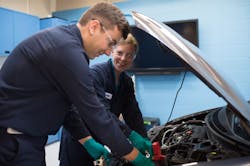This MTD exclusive was provided by Dennis McCarron, a partner at Cardinal Brokers, one of the leading brokers in the tire and automotive industry (www.cardinalbrokers.com).
A few years ago, it was stated that the average age of an ASE master-certified technician in the United States was approaching 60 years old. That’s a lot of wear and tear on the human body — a lot of busted knuckles, kneeling on cold concrete and staying after hours to finish a job that should have taken an hour, but a busted bolt turned it into a nightmare.
The average age of an ASE-certified technician today, according to one source, is 40 years old. How can that be? Well, I know what didn’t happen was a flood of new, energetic, able-bodied and eager folks decided during the pandemic to become ASE master-certified. What it appears to be is two-fold.
First, the baby boomers retired. Boomers made up a huge percentage of this kind of technician. If the average age of this technician was almost 60, you know the top age wasn’t more than about 65. So over the last few years, there’s been an increase in retirements by sheer necessity.
The second factor is a little harder to see. Under the big number is a breakdown of how it spreads out. Fifty percent of technicians are over 40 — there’s no cap on the top number — while 25% are 30 to 40 years old and 25% are 20 to 30 years old and are likely closer to 30 by the nature of testing requirements.
It would be interesting to see the numbers in five-year increments, but that data is not available.
So we’ve seen a great tide of retirements and a shrinking workforce decades in the making. Part of this can be blamed on the enormous push by the education system to put high school kids in college and drop any kind of shop or vo-tech classes.
Amazingly, the estimated job growth for technicians is expected to decline just over 3.5% over the next 10 years, even though wages are rising, technology is advancing at breakneck speeds, shops are finally evolving into the shops of tomorrow and the number of cars on the road isn’t going down.
Simple math tells you if demand is consistent or increasing and the ability to service that demand is declining, you’re going to have some problems. What can you do to get ahead of this situation? Let’s look at three potential solutions.
Get aggressive. This is going to be the most controversial point. Some refer to this as “stealing” technicians from other shops. I’ve never been a big fan of this concept. However, I’ve had many lively debates about what actually constitutes a “theft.” If a technician is very unhappy where he or she is currently working and you can vastly improve that person’s work life, is it stealing? I’m sure we could all debate about where the line gets drawn.
Get ready to spend a lot of money on training. This is the sweet spot. You hire for attitude and approach to work in general and teach/train the specifics. For too long as an industry, we just hired people and they got right to work, pumping out oil changes and flat repairs. We are in a drastically different time now. Owners of tire dealerships must begin to dedicate a significant allocation of resources in training and development in young technicians. Weekly time must be spent on skill development.
There’s a myriad of types of training available, from one-on-one training with local experts to online and industry-recognized programs like those offered by the Tire Industry Association.
Get rid of the old ways of looking for employees. Two of the most frustrating things to hear in our industry are “I’m too busy to go out looking for techs” and “Well, it’s been slow, so I don’t think I can afford another tech right now.” As an industry, we need to go out looking for people who aren’t looking for us. Unemployment is 3.9%. There aren’t many highly desired mechanics wandering around town, desperate to find a job. And as mentioned earlier, the funnel of high school graduates entering skilled trades was cut off years ago. You must create the interest yourself. You must connect with the right person, create a multi-faceted development plan and then execute and follow through.
Even though the warning bells were sounded years back, all is not lost. This isn’t a doom and gloom column. It’s a wake-up call to change.
There’s plenty of profit to be made, which can support a robust training and development program for young technicians. And there are still bad employers that have good employees who want a change of scenery. Get creative in your employee search.
About the Author

Dennis McCarron
Dennis McCarron is a partner at Cardinal Brokers Inc., one of the leading brokers in the tire and automotive industry (www.cardinalbrokers.com.) To contact McCarron, email him at [email protected].
